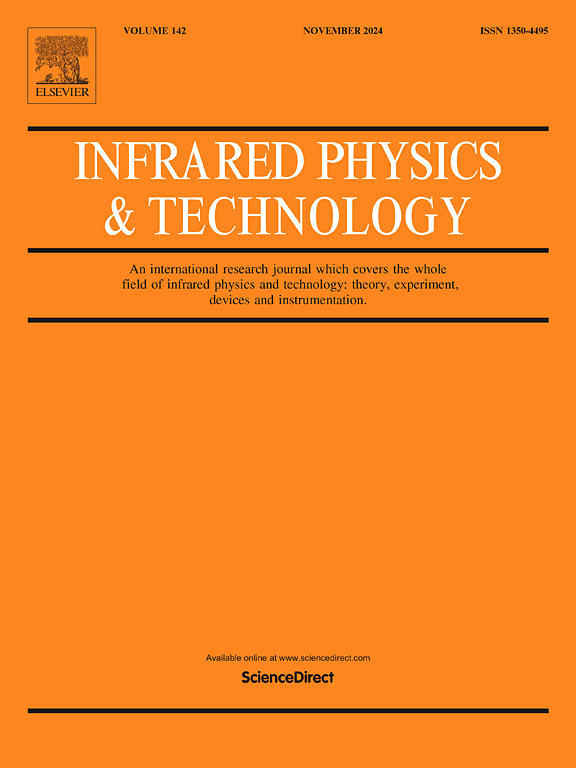基于低秩耦合字典学习的多光谱图像超分辨率重建
IF 3.4
3区 物理与天体物理
Q2 INSTRUMENTS & INSTRUMENTATION
引用次数: 0
摘要
光谱超分辨重建利用辅助信息和样本学习来挖掘多光谱图像到高光谱图像的光谱映射关系。从多光谱和高光谱图像对中估计回归矩阵是一个欠确定问题,先验信息往往有利于模型寻求更精确的光谱映射关系。因此,基于高光谱图像的光谱低秩,将光谱超分辨率重建视为图像低秩重建问题,提出了一种基于低秩耦合字典学习的光谱超分辨率重建方法。该方法首先对重叠区域不同光谱分辨率的多光谱和高光谱图像创建耦合字典,将字典秩最小化融入字典学习的稀疏表示中,推导并构建了基于ADMM算法的光谱字典和稀疏系数的优化学习过程,从而减少了稀疏误差传播和图像中的冗余信息。得到的低秩耦合字典保证了图像的稳定重建。随后,利用重建区域多光谱图像的稀疏系数,结合高光谱图像的低秩字典,实现光谱超分辨率重建。为了验证该算法的准确性,利用两组真实数据集(ZY1-02D和GF5)进行了实验。实验结果表明,与对比方法相比,本文方法在元素重构质量(RMSE和ERGAS)、空间重构质量(PSNR)、光谱重构质量(SAM)和空间结构重构质量(SSIM)等方面的重构精度均有提高。为了探索该方法的应用价值,选取与本文数据集相似环境的多光谱图像作为实验对象。利用优化后的字典,通过迁移学习更方便地重构出高质量的光谱超分辨产品。实验结果验证了该方法在实际应用环境中的可行性,有效降低了高光谱图像的获取成本。本文章由计算机程序翻译,如有差异,请以英文原文为准。
Spectral super-resolution reconstruction of multispectral images based on low-rank coupled dictionary learning
Spectral super-resolution reconstruction uses auxiliary information and sample learning to mine the spectral mapping relationship from multispectral images to hyperspectral images. Estimating the regression matrix from pairs of multispectral and hyperspectral images is an underdetermined problem, and prior information is often beneficial for the model to seek a more accurate spectral mapping relationship. Therefore, based on the spectral low-rank of hyperspectral images, the spectral super-resolution reconstruction is regarded as the problem of image low-rank reconstruction, and a spectral super-resolution reconstruction method based on low-rank coupled dictionary learning is proposed. Firstly, the method creates a coupling dictionary for multispectral and hyperspectral images with different spectral resolutions in the overlapping region, integrates the minimization of dictionary rank into the sparse representation of dictionary learning, and derives and constructs the optimized learning process of spectral dictionary and sparse coefficient based on ADMM algorithm, thereby reducing sparse error propagation and redundant information in the images. The obtained low-rank coupled dictionary ensures stable reconstruction of the images. Subsequently, the sparse coefficient of the multispectral images of the reconstruction region are utilized, combined with the low-rank dictionary of the hyperspectral images, to achieve spectral super-resolution reconstruction. To investigate the accuracy of the proposed algorithm, experiments were conducted using two sets of real datasets, ZY1-02D and GF5. The experimental results indicate that, compared to the contrast methods, the reconstruction accuracy of the proposed method has improved from the perspectives of element reconstruction quality (RMSE and ERGAS), spatial reconstruction quality (PSNR), spectral reconstruction quality (SAM), and spatial structural reconstruction quality (SSIM). To explore the application value of the proposed method, multispectral images from environments similar to the dataset used in this paper were selected as experimental subjects. Using the optimized dictionary from this paper, high-quality spectral super-resolution products were reconstructed more conveniently through transfer learning. The experimental results confirm the feasibility of the proposed method in practical application environments, effectively reducing the cost of obtaining hyperspectral images.
求助全文
通过发布文献求助,成功后即可免费获取论文全文。
去求助
来源期刊
CiteScore
5.70
自引率
12.10%
发文量
400
审稿时长
67 days
期刊介绍:
The Journal covers the entire field of infrared physics and technology: theory, experiment, application, devices and instrumentation. Infrared'' is defined as covering the near, mid and far infrared (terahertz) regions from 0.75um (750nm) to 1mm (300GHz.) Submissions in the 300GHz to 100GHz region may be accepted at the editors discretion if their content is relevant to shorter wavelengths. Submissions must be primarily concerned with and directly relevant to this spectral region.
Its core topics can be summarized as the generation, propagation and detection, of infrared radiation; the associated optics, materials and devices; and its use in all fields of science, industry, engineering and medicine.
Infrared techniques occur in many different fields, notably spectroscopy and interferometry; material characterization and processing; atmospheric physics, astronomy and space research. Scientific aspects include lasers, quantum optics, quantum electronics, image processing and semiconductor physics. Some important applications are medical diagnostics and treatment, industrial inspection and environmental monitoring.

 求助内容:
求助内容: 应助结果提醒方式:
应助结果提醒方式:


